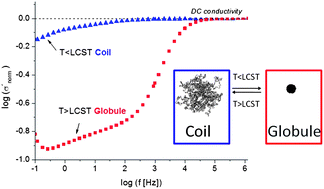Probing the phase transition of aqueous solutions of linear low molecular weight poly(N-isopropylacrylamide) by dielectric spectroscopy
Abstract
Aqueous solutions of linear poly(N-isopropylacrylamide) (pNIPAM) with different

* Corresponding authors
a
BAM Bundesanstalt für Materialforschung und -prüfung, Unter den Eichen 87, 12205 Berlin, Germany
E-mail:
andreas.schoenhals@bam.de
Fax: +49-30-81041637
Tel: +49-30-81043384
b Stranski-Laboratorium für Physikalische und Theoretische Chemie/Institut für Chemie, Technische Universität Berlin, Strasse des 17. Juni 124, 10623 Berlin, Germany
Aqueous solutions of linear poly(N-isopropylacrylamide) (pNIPAM) with different

 Please wait while we load your content...
Something went wrong. Try again?
Please wait while we load your content...
Something went wrong. Try again?
M. Füllbrandt, R. von Klitzing and A. Schönhals, Soft Matter, 2012, 8, 12116 DOI: 10.1039/C2SM26826D
To request permission to reproduce material from this article, please go to the Copyright Clearance Center request page.
If you are an author contributing to an RSC publication, you do not need to request permission provided correct acknowledgement is given.
If you are the author of this article, you do not need to request permission to reproduce figures and diagrams provided correct acknowledgement is given. If you want to reproduce the whole article in a third-party publication (excluding your thesis/dissertation for which permission is not required) please go to the Copyright Clearance Center request page.
Read more about how to correctly acknowledge RSC content.
 Fetching data from CrossRef.
Fetching data from CrossRef.
This may take some time to load.
Loading related content
